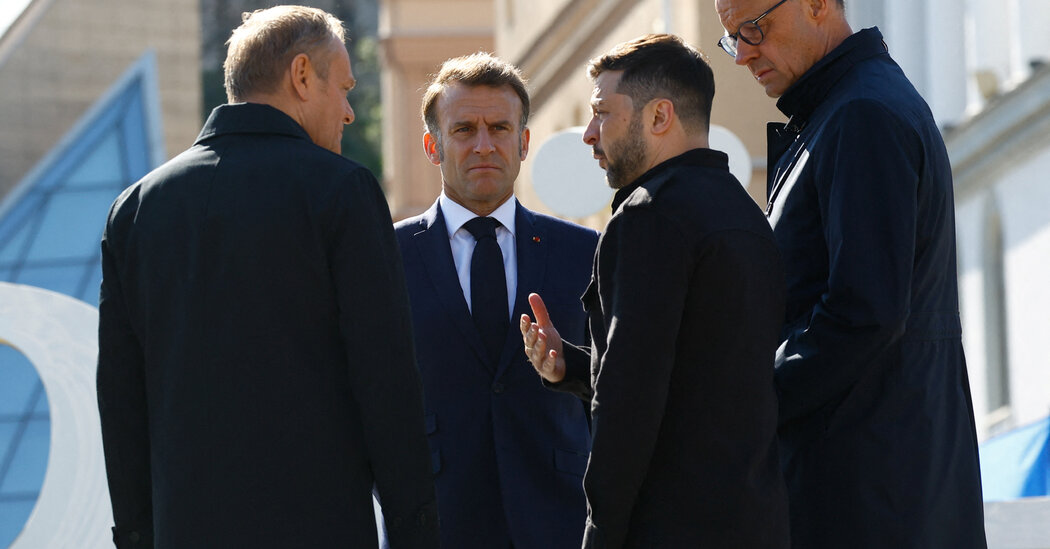The leaders of Britain, France, Germany and Poland arrived together in Kyiv on Saturday for their first-ever joint visit to Ukraine, pledging to intensify pressure on Russia until it agreed to a full, unconditional 30-day cease-fire.
Ukraine’s foreign minister, Andrii Sybiha, released a photograph of President Volodymyr Zelensky and the four other European leaders huddled around a phone as, Mr. Sybiha said, they spoke with President Trump.
“Ukraine and all allies are ready for a full unconditional ceasefire on land, air, and at sea for at least 30 days starting already on Monday,” Mr. Sybiha wrote on social media. “If Russia agrees and effective monitoring is ensured, a durable ceasefire and confidence-building measures can pave the way to peace negotiations.”
The visit was intended to underscore Europe’s commitment to Ukraine after more than three years of war with Russia. It came one day after Russia’s celebration of the 80th anniversary of the end of World War II, during which President Vladimir V. Putin welcomed President Xi Jinping of China and other foreign dignitaries to Moscow for a military parade meant to project Russia’s power and Mr. Putin’s bid to reshape the global order on his terms.
The two events crystallized both the changing contours of the war in Ukraine and the broader geopolitical shift underway since Mr. Trump entered office. In just a few months, Mr. Trump has reversed core tenets of U.S. foreign policy, and is presiding over the weakening of the trans-Atlantic bond that helped set Europe on the path to peace after the cataclysm of World War II.
At the moment, Ukraine is caught between an emboldened Russia, buoyed by China, North Korea and Iran, and a Europe scrambling to fill the void left by the United States.
It has been more than 120 days since the United States announced a new round of military assistance to Ukraine. It remains unclear if the Trump administration plans to spend the remaining $3.85 billion that Congress has authorized for additional withdrawals from the Defense Department’s stockpiles.
Most of the pressure Washington has brought to bear to end the fighting has been directed at Kyiv, though Mr. Trump has recently shown flashes of frustration with Moscow.
European leaders are hoping that frustration may lead Washington to take steps to pressure Moscow directly, perhaps by increasing sanctions aimed at the oil and gas revenues the Kremlin uses to finance its war efforts.
Dmitri S. Peskov, the Kremlin spokesman, dismissed the threat of new sanctions by Western leaders, on Saturday telling the Russian broadcaster Rossiya-1 that the country is “accustomed to such pressure measures and knows how to minimize their consequences.”
Daniel Fried, a former top U.S. diplomat and fellow at the Atlantic Council in Washington, said there was hope that the American and European policies on Ukraine are converging but many tests remained.
“The moment of truth” will come, he said, if Mr. Putin refuses the 30-day cease-fire, raising the questions of whether United States imposes more sanctions and offers more military assistance.
If there is a cease-fire, he said, the next test may come if Russia violates the truce.
“What, then, will be the U.S. response?” he said.
The visit by the European leaders, he said, was a smart response to the Mr. Putin’s recent propaganda blitz and an important demonstration of solidarity.
France’s president, Emmanuel Macron; the new German chancellor, Friedrich Merz; the British prime minister, Keir Starmer; and the Polish prime minister, Donald Tusk, started their visit to Kyiv with a solemn tribute to the thousands of Ukrainian soldiers killed in battle, laying flowers at a makeshift memorial in the capital.
The European leaders said they would discuss ways to strengthen the Ukrainian military to ensure that any future peace deal proves enduring. Along with President Volodymyr Zelensky of Ukraine, they were scheduled to hold a virtual briefing with other world leaders that make up a group they are calling a “coalition of the willing.”
But the coming weeks will test whether European resolve and resources can match the scale of the challenge as the war’s outcome increasingly becomes Europe’s problem to solve.
Despite months of frenetic diplomatic activity and Mr. Trump’s stated desire to bring the fighting to an end, the chasm separating the warring sides is as deep as ever.
Kyiv has agreed to the unconditional 30-day cease-fire proposed by the United States. At the same time, Ukraine is racing to build up its domestic arms production and its European allies have increased their military assistance. Even if Russia agrees to a cease-fire, Ukraine and its allies believe that the only way to ensure an enduring peace is through military strength.
Mr. Peskov, the Kremlin spokesman, said on Saturday that Russia remained opposed to any cease-fire unless Western nations stopped providing military aid to Ukraine, according to the Russian news agency Tass.
Mr. Putin has said that he wants to keep control over the roughly 20 percent of Ukraine that his forces have conquered but that he also wants Kyiv to surrender wide swaths of eastern and southern Ukraine that his military has failed to seize











